Traveling Waves Vs Standing Wave
Traveling Waves Vs Standing Wave
Uploaded by
Mageshkumar GunasekarCopyright:
Available Formats
Traveling Waves Vs Standing Wave
Traveling Waves Vs Standing Wave
Uploaded by
Mageshkumar GunasekarOriginal Description:
Original Title
Copyright
Available Formats
Share this document
Did you find this document useful?
Is this content inappropriate?
Copyright:
Available Formats
Traveling Waves Vs Standing Wave
Traveling Waves Vs Standing Wave
Uploaded by
Mageshkumar GunasekarCopyright:
Available Formats
Traveling Waves vs.
Standing Waves
A mechanical wave is a disturbance that is created by a vibrating object and subsequently travels through a medium from one location to another, transporting energy as it moves. The mechanism by which a mechanical wave propagates itself through a medium involves particle interaction; one particle applies a push or pull on its adjacent neighbor, causing a displacement of that neighbor from the equilibrium or rest position. As a wave is observed traveling through a medium, a crest is seen moving along from particle to particle. This crest is followed by a trough that is in turn followed by the next crest. In fact, one would observe a distinct wave pattern (in the form of a sine wave) traveling through the medium. This sine wave pattern continues to move in uninterrupted fashion until it encounters another wave along the medium or until it encounters a boundary with another medium. This type of wave pattern that is seen traveling through a medium is sometimes referred to as a traveling wave. Traveling waves are observed when a wave is not confined to a given space along the medium. The most commonly observed traveling wave is an ocean wave. If a wave is introduced into an elastic cord with its ends held 3 meters apart, it becomes confined in a small region. Such a wave has only 3 meters along which to travel. The wave will quickly reach the end of the cord, reflect and travel back in the opposite direction. Any reflected portion of the wave will then interfere with the portion of the wave incident towards the fixed end. This interference produces a new shape in the medium that seldom resembles the shape of a sine wave. Subsequently, a traveling wave (a repeating pattern that is observed to move through a medium in uninterrupted fashion) is not observed in the cord. Indeed there are traveling waves in the cord; it is just that they are not easily detectable because of their interference with each other. In such instances, rather than observing the pure shape of a sine wave pattern, a rather irregular and non-repeating pattern is produced in the cord that tends to change appearance over time. This irregular looking shape is the result of the interference of an incident sine wave pattern with a reflected sine wave pattern in a rather non-sequenced and untimely manner. Both the incident and reflected wave patterns continue their motion through the medium, meeting up with one another at different locations in different ways. For example, the middle of the cord might experience a crest meeting a half crest; then moments later, a crest meeting a quarter trough; then moments later, a three-quarters crest meeting a one-fifth trough, etc. This interference leads to a very irregular and non-repeating motion of the medium. The appearance of an actual wave pattern is difficult to detect amidst the irregular motions of the individual particles. It is however possible to have a wave confined to a given space in a medium and still produce a regular wave pattern that is readily discernible amidst the motion of the medium. For instance, if an elastic rope is held end-to-end and vibrated at just the right frequency, a wave pattern would be produced that assumes the shape of a sine wave and is seen to change over time. The wave pattern is only produced when one end of the rope is vibrated at just the right frequency. When the proper frequency is used, the interference of the incident wave and the reflected wave occur in such a manner that there are specific points along the medium that appear to be standing still. Because the observed wave pattern is characterized by points that appear to be standing still, the pattern is often called a standing wave pattern. There are other points along the medium whose displacement changes over time, but in a regular manner. These points vibrate back and forth from a positive displacement to a negative displacement; the vibrations occur at regular time intervals such that the motion of the medium is regular and repeating. A pattern is readily observable. The diagram at the right depicts a standing wave pattern in a medium. A snapshot of the medium over time is depicted using various colors. Note that point A on the medium moves from a maximum positive to a maximum negative displacement over time. The diagram only shows onehalf cycle of the motion of the standing wave pattern. The motion would continue and persist, with point A returning to the same maximum positive displacement and then continuing its back-and-forth vibration between the up to the down
position. Note that point B on the medium is a point that never moves. Point B is a point of no displacement. Such points are known as nodes and will be discussed in more detail later in this lesson. The standing wave pattern that is shown at the right is just one of many different patterns that could be produced within the rope. Other patterns will be discussed later in the lesson.
Formation of Standing Waves
A standing wave pattern is a vibrational pattern created within a medium when the vibrational frequency of the source causes reflected waves from one end of the medium to interfere with incident waves from the source. This interference occurs in such a manner that specific points along the medium appear to be standing still. Because the observed wave pattern is characterized by points that appear to be standing still, the pattern is often called a standing wave pattern. Such patterns are only created within the medium at specific frequencies of vibration. These frequencies are known as harmonic frequencies, or merely harmonics. At any frequency other than a harmonic frequency, the interference of reflected and incident waves leads to a resulting disturbance of the medium that is irregular and non-repeating. But how are standing wave formations formed? And why are they only formed when the medium is vibrated at specific frequencies? And what makes these socalled harmonic frequencies so special and magical? To answer these questions, let's consider a snakey stretched across the room, approximately 4-meters from end to end. (A "snakey" is a slinky-like device that consists of a large concentration of small-diameter metal coils.) If an upward displaced pulse is introduced at the left end of the snakey, it will travel rightward across the snakey until it reaches the fixed end on the right side of the snakey. Upon reaching the fixed end, the single pulse will reflect and undergo inversion. That is, the upward displaced pulse will become a downward displaced pulse. Now suppose that a second upward displaced pulse is introduced into the snakey at the precise moment that the first crest undergoes its fixed end reflection. If this is done with perfect timing, a rightward moving, upward displaced pulse will meet up with a leftward moving, downward displaced pulse in the exact middle of the snakey. As the two pulses pass through each other, they will undergo destructive interference. Thus, a point of no displacement in the exact middle of the snakey will be produced. The animation below shows several snapshots of the meeting of the two pulses at various stages in their interference. The individual pulses are drawn in blue and red; the resulting shape of the medium (as found by the principle of superposition) is shown in green. Note that there is a point on the diagram in the exact middle of the medium that never experiences any displacement from the equilibrium position.
An upward displaced pulse introduced at one end will destructively interfere in the exact middle of the snakey with a second upward displaced pulse introduced from the same end if the introduction of the second pulse is performed with perfect timing. The same rationale could be applied to two downward displaced pulses introduced from the same end. If the second pulse is introduced at precisely the moment that the first pulse is reflecting from the fixed end, then destructive interference will occur in the exact middle of the snakey. The above discussion only explains why two pulses might interfere destructively to produce a point of no displacement in the middle of the snakey. A wave is certainly different than a pulse. What if there are two waves traveling in the medium? Understanding why two waves introduced into a medium with perfect timing might produce a point of displacement in the middle of the medium is a mere extension of the above discussion. While a pulse is a single
disturbance that moves through a medium, a wave is a repeating pattern of crests and troughs. Thus, a wave can be thought of as an upward displaced pulse (crest) followed by a downward displaced pulse (trough) followed by an upward displaced pulse (crest) followed by a downward displaced pulse (trough) followed by... . Since the introduction of a crest is followed by the introduction of a trough, every crest and trough will destructively interfere in such a way that the middle of the medium is a point of no displacement. Of course, this all demands that the timing is perfect. In the above discussion, perfect timing was achieved if every wave crest was introduced into the snakey at the precise time that the previous wave crest began its reflection at the fixed end. In this situation, there will be one complete wavelength within the snakey moving to the right at every instant in time; this incident wave will meet up with one complete wavelength moving to the left at every instant in time. Under these conditions, destructive interference always occurs in the middle of the snakey. Either a full crest meets a full trough or a half-crest meets a half-trough or a quarter-crest meets a quarter-trough at this point. The animation below represents several snapshots of two waves traveling in opposite directions along the same medium. The waves are interfering in such a manner that there are points of no displacement produced at the same positions along the medium. These points along the medium are known as nodes and are labeled with an N. There are also points along the medium that vibrate back and forth between points of large positive displacement and points of large negative displacement. These points are known as antinodes and are labeled with an AN. The two individual waves are drawn in blue and green and the resulting shape of the medium is drawn in black.
There are other ways to achieve this perfect timing. The main idea behind the timing is to introduce a crest at the instant that another crest is either at the halfway point across the medium or at the end of the medium. Regardless of the number of crests and troughs that are in between, if a crest is introduced at the instant another crest is undergoing its fixed end reflection, a node (point of no displacement) will be formed in the middle of the medium. The number of other nodes that will be present along the medium is dependent upon the number of crests that were present in between the two timed crests. If a crest is introduced at the instant another crest is at the halfway point across the medium, then an antinode (point of maximum displacement) will be formed in the middle of the medium by means of constructive interference. In such an instance, there might also be nodes and antinodes located elsewhere along the medium. A standing wave pattern is an interference phenomenon. It is formed as the result of the perfectly timed interference of two waves passing through the same medium. A standing wave pattern is not actually a wave; rather it is the pattern resulting from the presence of two waves (sometimes more) of the same frequency with different directions of travel within the same medium. The physics of musical instruments has a basis in the conceptual and mathematical aspects of standing waves. For this reason, the topic will be revisited in the Sound and Music unit at The Physics Classroom Tutorial.
Nodes and Anti-nodes
As mentioned earlier in Lesson 4, a standing wave pattern is an interference phenomenon. It is formed as the result of the perfectly timed interference of two waves passing through the same medium. A standing wave pattern is not actually a wave; rather it is the pattern resulting from the
presence of two waves of the same frequency with different directions of travel within the same medium. One characteristic of every standing wave pattern is that there are points along the medium that appear to be standing still. These points, sometimes described as points of no displacement, are referred to as nodes. There are other points along the medium that undergo vibrations between a large positive and large negative displacement. These are the points that undergo the maximum displacement during each vibrational cycle of the standing wave. In a sense, these points are the opposite of nodes, and so they are called antinodes. A standing wave pattern always consists of an alternating pattern of nodes and antinodes. The animation shown below depicts a rope vibrating with a standing wave pattern. The nodes and antinodes are labeled on the diagram. When a standing wave pattern is established in a medium, the nodes and the antinodes are always located at the same position along the medium; they are standing still. It is this characteristic that has earned the pattern the namestanding wave.
Flickr Physics Photo
A standing wave is established upon a vibrating string using a harmonic oscillator and a frequency generator. A strobe is used to illuminate the string several times during each cycle. The finger is pointing at a nodal position.
The positioning of the nodes and antinodes in a standing wave pattern can be explained by focusing on the interference of the two waves. The nodes are produced at locations where destructive interference occurs. For instance, nodes form at locations where a crest of one wave meets a trough of a second wave; or a half-crest of one wave meets a half-trough of a second wave; or a quartercrest of one wave meets a quarter-trough of a second wave; etc. Antinodes, on the other hand, are produced at locations where constructive interference occurs. For instance, if a crest of one wave meets a crest of a second wave, a point of large positive displacement results. Similarly, if a trough of one wave meets a trough of a second wave, a point of large negative displacement results. Antinodes are always vibrating back and forth between these points of large positive and large negative displacement; this is because during a complete cycle of vibration, a crest will meet a crest; and then one-half cycle later, a trough will meet a trough. Because antinodes are vibrating back and forth between a large positive and large negative displacement, a diagram of a standing wave is sometimes depicted by drawing the shape of the medium at an instant in time and at an instant one-half vibrational cycle later. This is done in the diagram below.
Nodes and antinodes should not be confused with crests and troughs. When the motion of a traveling wave is discussed, it is customary to refer to a point of large maximum displacement as a crest and a point of large negative displacement as a trough. These represent points of the disturbance that travel from one location to another through the medium. An antinode on the other hand is a point on the medium that is staying in the same location. Furthermore, an antinode vibrates back and forth between a large upward and a large downward displacement. And finally, nodes and antinodes are not actually part of a wave. Recall that a standing wave is not actually a wave but rather a pattern that
results from the interference of two or more waves. Since a standing wave is not technically a wave, an antinode is not technically a point on a wave. The nodes and antinodes are merely unique points on the medium that make up the wave pattern.
Mathematics of Standing Waves
As discussed in Lesson 4, standing wave patterns are wave patterns produced in a medium when two waves of identical frequencies interfere in such a manner to produce points along the medium that always appear to be standing still. Such standing wave patterns are produced within the medium when it is vibrated at certain frequencies. Each frequency is associated with a different standing wave pattern. These frequencies and their associated wave patterns are referred to as harmonics. A careful study of the standing wave patterns reveal a clear mathematical relationship between the wavelength of the wave that produces the pattern and the length of the medium in which the pattern is displayed. Furthermore, there is a predictability about this mathematical relationship that allows one to generalize and deduce a statement concerning this relationship. To illustrate, consider the first harmonic standing wave pattern for a vibrating rope as shown below.
The pattern for the first harmonic reveals a single antinode in the middle of the rope. This antinode position along the rope vibrates up and down from a maximum upward displacement from rest to a maximum downward displacement as shown. The vibration of the rope in this manner creates the appearance of a loop within the string. A complete wave in a pattern could be described as starting at the rest position, rising upward to a peak displacement, returning back down to a rest position, then descending to a peak downward displacement and finally returning back to the rest position. The animation below depicts this familiar pattern. As shown in the animation, one complete wave in a standing wave pattern consists of two loops. Thus, one loop is equivalent to one-half of a wavelength.
In comparing the standing wave pattern for the first harmonic with its single loop to the diagram of a complete wave, it is evident that there is only one-half of a wave stretching across the length of the string. That is, the length of the string is equal to one-half the length of a wave. Put in the form of an equation:
Now consider the string being vibrated with a frequency that establishes the standing wave pattern for the second harmonic.
The second harmonic pattern consists of two anti-nodes. Thus, there are two loops within the length of the string. Since each loop is equivalent to one-half a wavelength, the length of the string is equal to two-halves of a wavelength. Put in the form of an equation:
The same reasoning pattern can be applied to the case of the string being vibrated with a frequency that establishes the standing wave pattern for the third harmonic.
The third harmonic pattern consists of three anti-nodes. Thus, there are three loops within the length of the string. Since each loop is equivalent to one-half a wavelength, the length of the string is equal to three-halves of a wavelength. Put in the form of an equation:
When inspecting the standing wave patterns and the length-wavelength relationships for the first three harmonics, a clear pattern emerges. The number of antinodes in the pattern is equal to the harmonic number of that pattern. The first harmonic has one antinode; the second harmonic has two antinodes; and the third harmonic has three antinodes. Thus, it can be generalized that the nth harmonic has n antinodes where n is an integer representing the harmonic number. Furthermore, one notices that there are n halves wavelengths present within the length of the string. Put in the form of an equation:
This information is summarized in the table below. Length-Wavelength Relationship
Harmonic
Pattern
# of Loops
1st
L=1/2
2nd
L=2/2
3rd
L=3/2
4th
L=4/2
5th
L=5/2
6th
L=6/2
nth
--
L=n/2
For standing wave patterns, there is a clear mathematical relationship between the length of a string and the wavelength of the wave that creates the pattern. The mathematical relationship simply emerges from the inspection of the pattern and the understanding that each loop in the pattern is equivalent to one-half of a wavelength. The general equation that describes this length-wavelength relationship for any harmonic is:
You might also like
- Ieee 2778-2020Document24 pagesIeee 2778-2020Cristhian Giovanni Silva OchoaNo ratings yet
- Comparative Life Cycle Assessment of Milk and Plant-Based AlternativesDocument3 pagesComparative Life Cycle Assessment of Milk and Plant-Based AlternativesArman SaeedtaheriNo ratings yet
- Solution ManualDocument100 pagesSolution ManualmichaelNo ratings yet
- Appendix B - Descriptions of The 230 Space GroupsDocument36 pagesAppendix B - Descriptions of The 230 Space GroupsQiang Sun100% (1)
- UltrasonographyDocument5 pagesUltrasonographyapi-272007868No ratings yet
- Electromagnetic Radiation: Electromagnetic Radiation (EM Radiation or EMR) Is A Form of EnergyDocument21 pagesElectromagnetic Radiation: Electromagnetic Radiation (EM Radiation or EMR) Is A Form of EnergybekkuNo ratings yet
- 18GET51 UNIVERSAL HUMAN VALUES-with-COPO-mappingDocument2 pages18GET51 UNIVERSAL HUMAN VALUES-with-COPO-mappingMageshkumar Gunasekar100% (1)
- SASO StandardsDocument73 pagesSASO StandardsLloyd R. Ponce40% (5)
- PHYSICS Kannur University 2012 SyllabusDocument53 pagesPHYSICS Kannur University 2012 SyllabusCiby AbrahamNo ratings yet
- WavesDocument18 pagesWavesMbrn AliNo ratings yet
- Radiation Hazards VDocument39 pagesRadiation Hazards VSWATINo ratings yet
- Electromagnetic Waves WSDocument4 pagesElectromagnetic Waves WSSonny ArgolidaNo ratings yet
- Photon Interaction With MatterDocument16 pagesPhoton Interaction With MatterShafuan WanNo ratings yet
- Basic Radiation BiologyDocument25 pagesBasic Radiation Biologysazaki224No ratings yet
- Chapter 5 Radioactivity: Writing Nuclear Reaction EquationDocument2 pagesChapter 5 Radioactivity: Writing Nuclear Reaction Equationleelee1127100% (1)
- Basics of RadiobiologyDocument61 pagesBasics of RadiobiologyLikhon Amin AponNo ratings yet
- Interaction of Radiation With MatterDocument34 pagesInteraction of Radiation With Mattertarek el zayat100% (1)
- Atomic and Molecular Spectroscopy-2 PDFDocument60 pagesAtomic and Molecular Spectroscopy-2 PDFHaseeb HaiderNo ratings yet
- Magnetic Resonance ImagingDocument149 pagesMagnetic Resonance ImagingJohn Lerdon ReynaNo ratings yet
- Radiology Test 3 Study GuideDocument5 pagesRadiology Test 3 Study GuideLolita A. HicksNo ratings yet
- Magnetic Susceptability WikiDocument264 pagesMagnetic Susceptability WikiChris NadovichNo ratings yet
- Principles of NanometrologyDocument33 pagesPrinciples of NanometrologysahilmirNo ratings yet
- Standing WavesDocument35 pagesStanding WavesLouies Ungria100% (1)
- Linear Accelerator (Linac: Prepared by Seemab Zakir Biomedical EngineerDocument22 pagesLinear Accelerator (Linac: Prepared by Seemab Zakir Biomedical Engineerihsan ul haqNo ratings yet
- Neutron SourcesDocument64 pagesNeutron SourcesJenodi100% (1)
- Biological Effects of Ionizing RadiationDocument7 pagesBiological Effects of Ionizing RadiationMostak Ahmed RafiNo ratings yet
- Linear Accelerator: Group Members: Amna Shahzadi Ashiq Hayat Saneela Rafique Usama Bin IjazDocument26 pagesLinear Accelerator: Group Members: Amna Shahzadi Ashiq Hayat Saneela Rafique Usama Bin IjazMuhammad Haroon Khan100% (1)
- Physics Syllabus 13-15Document24 pagesPhysics Syllabus 13-15sanNo ratings yet
- The Oxygen Effect and ReoxygenationDocument47 pagesThe Oxygen Effect and ReoxygenationliskatriNo ratings yet
- AcceleratorDocument27 pagesAcceleratorM Agung Fatahillah100% (1)
- Computed Tomography (CT) - Body: Temb 3109B Medical Imaging Sensing and Processing 1Document7 pagesComputed Tomography (CT) - Body: Temb 3109B Medical Imaging Sensing and Processing 1iangarvinsNo ratings yet
- Notes - Radioactivity and Nuclear EnergyDocument28 pagesNotes - Radioactivity and Nuclear EnergyUlwindass Victor Gorge100% (1)
- Ionising Radiation and Living ThingsDocument23 pagesIonising Radiation and Living ThingsMunish DograNo ratings yet
- Atomic and Nuclear PhysicsDocument70 pagesAtomic and Nuclear PhysicsGiovanni SlackNo ratings yet
- 9 Item PDFDocument10 pages9 Item PDFandreaNo ratings yet
- Basic Dosimetric PrincipleDocument73 pagesBasic Dosimetric Principleradiologi rsud solokNo ratings yet
- X-Ray Production and InteractionsDocument8 pagesX-Ray Production and InteractionsHanan AliNo ratings yet
- Term Paper: Cosmic Rays and Its EffectsDocument13 pagesTerm Paper: Cosmic Rays and Its EffectsShreyashi UpadhyayNo ratings yet
- Interaction of Radiation With MatterDocument25 pagesInteraction of Radiation With Matterapi-3726116100% (5)
- Engineering Physics Optics MainDocument87 pagesEngineering Physics Optics MainHasan ZiauddinNo ratings yet
- Lecture On Nuclear ChemistryDocument58 pagesLecture On Nuclear Chemistrysadia SultanaNo ratings yet
- Doppler EffectDocument11 pagesDoppler EffectJoyceTangNo ratings yet
- Non-ionizing Radiation Protection: Summary of Research and Policy OptionsFrom EverandNon-ionizing Radiation Protection: Summary of Research and Policy OptionsNo ratings yet
- Contact AngleDocument7 pagesContact AngleOh Ha Ni OthmanNo ratings yet
- Radiation Detection Instrumentation Fundamentals Rev0Document157 pagesRadiation Detection Instrumentation Fundamentals Rev0amol9089No ratings yet
- Biological Effects of Ionizing Radiation: En. Mohd Fahmi B Mohd YusofDocument45 pagesBiological Effects of Ionizing Radiation: En. Mohd Fahmi B Mohd YusofFahmi BestNo ratings yet
- Solid State Chapter 2Document75 pagesSolid State Chapter 2Ambreen KhanNo ratings yet
- RelativityDocument42 pagesRelativityKarl Jimenez SeparaNo ratings yet
- Quantities and Units in Radiation Protection (CAMDingle)Document63 pagesQuantities and Units in Radiation Protection (CAMDingle)e cubeNo ratings yet
- Living With RadiationDocument75 pagesLiving With RadiationIkang FauziNo ratings yet
- IB Physics Climate ModellingDocument11 pagesIB Physics Climate ModellingAnara Noelle Chiongbian100% (1)
- Superposition of WavesDocument8 pagesSuperposition of Wavesdil19860209No ratings yet
- Physics A2Document4 pagesPhysics A2Faisal AnwarNo ratings yet
- Medical Physics ExamsDocument20 pagesMedical Physics ExamsAbdul Rahim RattaniNo ratings yet
- Microscopy LectureDocument27 pagesMicroscopy LectureMishal ZahraNo ratings yet
- Biological Effects of Radiation (Physics)Document13 pagesBiological Effects of Radiation (Physics)Josiah Dave CalumpangNo ratings yet
- Week 3 B Chapter 12 X-Ray Interaction With Matter 55Document37 pagesWeek 3 B Chapter 12 X-Ray Interaction With Matter 55Hanan AliNo ratings yet
- Knoll CH 1 Rad SourcesDocument59 pagesKnoll CH 1 Rad SourcesruqqiNo ratings yet
- Crystal Structures and X-Ray DiffractionDocument5 pagesCrystal Structures and X-Ray DiffractionV V Satyanarayana PasupuletiNo ratings yet
- Andrew Idoko Radiology GROUP 332 1. The Concept of Radical and Palliative Treatment. Indications, Contraindications Dose Limits. ExamplesDocument5 pagesAndrew Idoko Radiology GROUP 332 1. The Concept of Radical and Palliative Treatment. Indications, Contraindications Dose Limits. ExamplesdreNo ratings yet
- Nantenna Report NANO ANTENNA ENERGY HARVEST SOLAR ENERGYDocument32 pagesNantenna Report NANO ANTENNA ENERGY HARVEST SOLAR ENERGYRitesh kumar Nayak100% (1)
- Nuclear Physics: James T. Shipman Jerry D. Wilson Charles A. Higgins, Jr. Omar TorresDocument122 pagesNuclear Physics: James T. Shipman Jerry D. Wilson Charles A. Higgins, Jr. Omar Torrescarl jason talanNo ratings yet
- Radiation Safety of Accelerator Based Radioisotope Production Facilities: Specific Safety GuideFrom EverandRadiation Safety of Accelerator Based Radioisotope Production Facilities: Specific Safety GuideNo ratings yet
- Rights of Engineers 07 PDFDocument5 pagesRights of Engineers 07 PDFMageshkumar GunasekarNo ratings yet
- Problems On TrainsDocument41 pagesProblems On TrainsMageshkumar GunasekarNo ratings yet
- Department of Ece: Agni College of TechnologyDocument1 pageDepartment of Ece: Agni College of TechnologyMageshkumar GunasekarNo ratings yet
- Characteristics of PN Junction Diode and Zener DiodeDocument7 pagesCharacteristics of PN Junction Diode and Zener DiodeMegha UmeshaNo ratings yet
- Asu 160 PPM - 2165 Technical ManualDocument435 pagesAsu 160 PPM - 2165 Technical ManualAchmad GunawanNo ratings yet
- Finite Deformation Thermo-Mechanical Behavior of Thermally Induced Shape Memory PolymersDocument22 pagesFinite Deformation Thermo-Mechanical Behavior of Thermally Induced Shape Memory PolymersVeeturiVarunNo ratings yet
- Offshore Anchor Data For Preliminary Design of Anchors of Floating Offshore Wind TurbinesDocument41 pagesOffshore Anchor Data For Preliminary Design of Anchors of Floating Offshore Wind TurbinescarloNo ratings yet
- Natural Gas Trading Calendars 2023Document29 pagesNatural Gas Trading Calendars 2023Rina YenNo ratings yet
- TTS Marine Cargo Cranes: Technical InformationDocument3 pagesTTS Marine Cargo Cranes: Technical InformationDima KryzhanovskyiNo ratings yet
- 9P-100 Mud Pump Brochure PDFDocument2 pages9P-100 Mud Pump Brochure PDFSIOP IPC100% (1)
- Fin 242 - Report GroupDocument25 pagesFin 242 - Report Groupnurul shafifah bt ismail67% (3)
- ClinicDocument4 pagesClinicEngin OzsahinNo ratings yet
- Current Status of Nuclear Reactor Theory Weinberg1952Document13 pagesCurrent Status of Nuclear Reactor Theory Weinberg1952张坚No ratings yet
- Curing System For Mat-FoundationDocument8 pagesCuring System For Mat-FoundationDayo100% (1)
- 20220223-Quotation of YDF-300 Incinerator-Henan Yuanda BoilerDocument18 pages20220223-Quotation of YDF-300 Incinerator-Henan Yuanda BoilerJorge SepulvedaNo ratings yet
- Vastu ShastraDocument32 pagesVastu ShastraNAZIA ZAMAN 1706021No ratings yet
- Alternating CurrentDocument39 pagesAlternating CurrentRichard GomezNo ratings yet
- Hydrogen EnergyDocument14 pagesHydrogen EnergysdgalaponNo ratings yet
- Dr. Yanga's Colleges Inc.: College of Maritime EducationDocument2 pagesDr. Yanga's Colleges Inc.: College of Maritime EducationBeah monique FaustinoNo ratings yet
- Multiple Choice Questions IG1-2nd Monthly TestDocument5 pagesMultiple Choice Questions IG1-2nd Monthly TestrehanNo ratings yet
- Sany SCC1800A 180tonDocument68 pagesSany SCC1800A 180tonNunoNo ratings yet
- Cwipedia - In: Environmental Studies McqsDocument20 pagesCwipedia - In: Environmental Studies Mcqsdhananjay patilNo ratings yet
- LM79XX Series 3-Terminal Negative Regulators: FeaturesDocument13 pagesLM79XX Series 3-Terminal Negative Regulators: FeaturesDenis MartinićNo ratings yet
- SL05 455Document8 pagesSL05 455florinNo ratings yet
- Ar 09 MspxbwkneuDocument97 pagesAr 09 MspxbwkneuCarlos MelloNo ratings yet
- Sustainable Products ResearchDocument2 pagesSustainable Products Research袁浩森No ratings yet
- The Design of A 3 KW Solar Power Device For Class Rooms and Offices in The Federal Polytechnic Mubi IJERTV2IS121150Document5 pagesThe Design of A 3 KW Solar Power Device For Class Rooms and Offices in The Federal Polytechnic Mubi IJERTV2IS121150Mary Gold Ferolino CabralesNo ratings yet
- Hanwha Q CELLS Data Sheet QPEAK DUO-G5 315-330 2017-07 Rev01 EN PDFDocument2 pagesHanwha Q CELLS Data Sheet QPEAK DUO-G5 315-330 2017-07 Rev01 EN PDFDumitru GigiNo ratings yet
- Project - BMRDocument52 pagesProject - BMRLakshmi LuckyNo ratings yet
- Series N170-M3 and LFN170-M3 Installation InstructionsDocument12 pagesSeries N170-M3 and LFN170-M3 Installation InstructionsWattsNo ratings yet





























































































